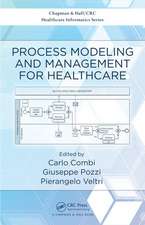Business Case Analysis with R: Simulation Tutorials to Support Complex Business Decisions
Autor Robert D. Brown IIIen Limba Engleză Paperback – 3 mar 2018
R has become one of the most widely used tools for reproducible quantitative analysis, and analysts fluent in this language are in high demand. The R language, traditionally used for statistical analysis, provides a more explicit, flexible, and extensible environment than spreadsheets for conducting business case analysis.
The main tutorial follows the case in which a chemical manufacturing company considers constructing a chemical reactor and production facility to bring a new compound to market. There are numerous uncertainties and risks involved, including the possibility that a competitor brings a similar product online. The company must determine the value of making the decision to move forward and where they might prioritize their attention to make a more informed and robust decision. While the example used is a chemical company, the analysis structure it presents can be applied to just about any business decision, from IT projects to new product development to commercial real estate. The supporting tutorials include the perspective of the founder of a professional service firm who wants to grow his business and a member of a strategic planning group in a biomedical device company who wants to know how much to budget in order to refine the quality of information about critical uncertainties that might affect the value of a chosen product development pathway.What You’ll Learn
- Set upa business case abstraction in an influence diagram to communicate the essence of the problem to other stakeholders
- Model the inherent uncertainties in the problem with Monte Carlo simulation using the R language
- Communicate the results graphically
- Draw appropriate insights from the results
- Develop creative decision strategies for thorough opportunity cost analysis
- Calculate the value of information on critical uncertainties between competing decision strategies to set the budget for deeper data analysis
- Construct appropriate information to satisfy the parameters for the Monte Carlo simulation when little or no empirical data are available
Financial analysts, data practitioners, and risk/business professionals; also appropriate for graduate level finance, business, or data science students
Preț: 185.27 lei
Preț vechi: 231.59 lei
-20% Nou
Puncte Express: 278
Preț estimativ în valută:
35.46€ • 36.58$ • 30.01£
35.46€ • 36.58$ • 30.01£
Carte disponibilă
Livrare economică 11-25 februarie
Preluare comenzi: 021 569.72.76
Specificații
ISBN-13: 9781484234945
ISBN-10: 1484234944
Pagini: 268
Ilustrații: XVIII, 282 p. 70 illus.
Dimensiuni: 178 x 254 x 20 mm
Greutate: 0.53 kg
Ediția:1st ed.
Editura: Apress
Colecția Apress
Locul publicării:Berkeley, CA, United States
ISBN-10: 1484234944
Pagini: 268
Ilustrații: XVIII, 282 p. 70 illus.
Dimensiuni: 178 x 254 x 20 mm
Greutate: 0.53 kg
Ediția:1st ed.
Editura: Apress
Colecția Apress
Locul publicării:Berkeley, CA, United States
Cuprins
Part 1: Business Case Analysis with R.- Chapter 1: A Relief from Spreadsheet Misery.- Chapter 2: Setting up the Analysis.- Chapter 3: Include Uncertainty in the Financial Analysis.- Chapter 4: Interpreting and Communicating Insights.- Part 2: It’s Your Move.- Chapter 5: "What Should I Do?".- Chapter 6: Use a Decision Hierarchy to Categorize Decision Types.- Chapter 7: Tame Decision Complexity by Creating a Strategy Table.- Chapter 8: Clearly Communicate the Intentions of Decision Strategies.- Chapter 9: What Comes Next.- Part 3: Subject Matter Expert Elicitation Guide.- Chapter 10: “What’s Your Number, Pardner?” .- Chapter 11: Conducting SME Elicitations.- Chapter 12: Kinds of Biases.- Part 4: Information Espresso.- Chapter 13: Setting a Budget for Making Decisions Clearly.- Chapter 14: A More Refined Explanation of VOI.- Chapter 15: Building the Simulation in R.- Appendix A: Deterministic Model.- Appendix B: Risk Model.- Appendix C: Simulation and Finance Functions.- Appendix D: Decision Hierarchy and Strategy Table Templates.- Appendix E: VOI Code Samples.-
Notă biografică
Robert D. Brown III is the President of Incite! Decision Technologies LLC, a consultancy supporting senior decision makers facing complex, high-risk opportunities. These opportunities usually include strategic planning, project selection, planning & risk management, and project portfolio analysis & management.
Mr. Brown has devoted his 20-year career to providing solutions to his clients' complex problems by employing creative thinking and advanced quantitative business, engineering, and systems analysis. His client experience spans diverse industrial and commercial fields, including petroleum & chemicals, energy, utilities, logistics & transportation, pharmaceuticals, electronics manufacturing, telecommunications, IT, commercial real estate, federal agencies, and education. Through Incite, Mr. Brown delivers analysis, decision support tools and systems, and training in decision making and risk management with the goal of helping his clients measure the value and therisk associated with the important decisions they face in order to make informed trade-offs and choices. Incite provides "Moneyball" for businesses.
Mr. Brown graduated from the Georgia Institute of Technology in 1992 with a bachelor degree in mechanical engineering (co-op program) with an emphasis in control systems.
Mr. Brown has devoted his 20-year career to providing solutions to his clients' complex problems by employing creative thinking and advanced quantitative business, engineering, and systems analysis. His client experience spans diverse industrial and commercial fields, including petroleum & chemicals, energy, utilities, logistics & transportation, pharmaceuticals, electronics manufacturing, telecommunications, IT, commercial real estate, federal agencies, and education. Through Incite, Mr. Brown delivers analysis, decision support tools and systems, and training in decision making and risk management with the goal of helping his clients measure the value and therisk associated with the important decisions they face in order to make informed trade-offs and choices. Incite provides "Moneyball" for businesses.
Mr. Brown graduated from the Georgia Institute of Technology in 1992 with a bachelor degree in mechanical engineering (co-op program) with an emphasis in control systems.
Textul de pe ultima copertă
This tutorial teaches you how to use the statistical programming language R to develop a business case simulation and analysis. It presents a methodology for conducting business case analysis that minimizes decision delay by focusing stakeholders on what matters most and suggests pathways for minimizing the risk in strategic and capital allocation decisions. Business case analysis, often conducted in spreadsheets, exposes decision makers to additional risks that arise just from the use of the spreadsheet environment.
R has become one of the most widely used tools for reproducible quantitative analysis, and analysts fluent in this language are in high demand. The R language, traditionally used for statistical analysis, provides a more explicit, flexible, and extensible environment than spreadsheets for conducting business case analysis.
The main tutorial follows the case in which a chemical manufacturing company considers constructing a chemical reactor and production facility to bring a new compound to market. There are numerous uncertainties and risks involved, including the possibility that a competitor brings a similar product online. The company must determine the value of making the decision to move forward and where they might prioritize their attention to make a more informed and robust decision. While the example used is a chemical company, the analysis structure it presents can be applied to just about any business decision, from IT projects to new product development to commercial real estate. The supporting tutorials include the perspective of the founder of a professional service firm who wants to grow his business and a member of a strategic planning group in a biomedical device company who wants to know how much to budget in order to refine the quality of information about critical uncertainties that might affect the value of a chosen product development pathway. What You’ll Learn:
R has become one of the most widely used tools for reproducible quantitative analysis, and analysts fluent in this language are in high demand. The R language, traditionally used for statistical analysis, provides a more explicit, flexible, and extensible environment than spreadsheets for conducting business case analysis.
The main tutorial follows the case in which a chemical manufacturing company considers constructing a chemical reactor and production facility to bring a new compound to market. There are numerous uncertainties and risks involved, including the possibility that a competitor brings a similar product online. The company must determine the value of making the decision to move forward and where they might prioritize their attention to make a more informed and robust decision. While the example used is a chemical company, the analysis structure it presents can be applied to just about any business decision, from IT projects to new product development to commercial real estate. The supporting tutorials include the perspective of the founder of a professional service firm who wants to grow his business and a member of a strategic planning group in a biomedical device company who wants to know how much to budget in order to refine the quality of information about critical uncertainties that might affect the value of a chosen product development pathway. What You’ll Learn:
- Set up a business case abstraction in an influence diagram to communicate the essence of the problem to other stakeholders
- Model the inherent uncertainties in the problem with Monte Carlo simulation using the R language
- Communicate the results graphically
- Draw appropriate insights from the results
- Develop creative decision strategies for thorough opportunity cost analysis
- Calculate the value of information on critical uncertainties between competing decision strategies to set the budget for deeper data analysis
- Construct appropriate information to satisfy the parameters for the Monte Carlo simulation when little or no empirical data are available
Caracteristici
Teaches how to use the R programming language for business case analysis Extends the analytic tool kit of financial analysts Establishes both a quality standard and a clearly auditable structure for ensuring that avoidable modeling errors are minimized


























